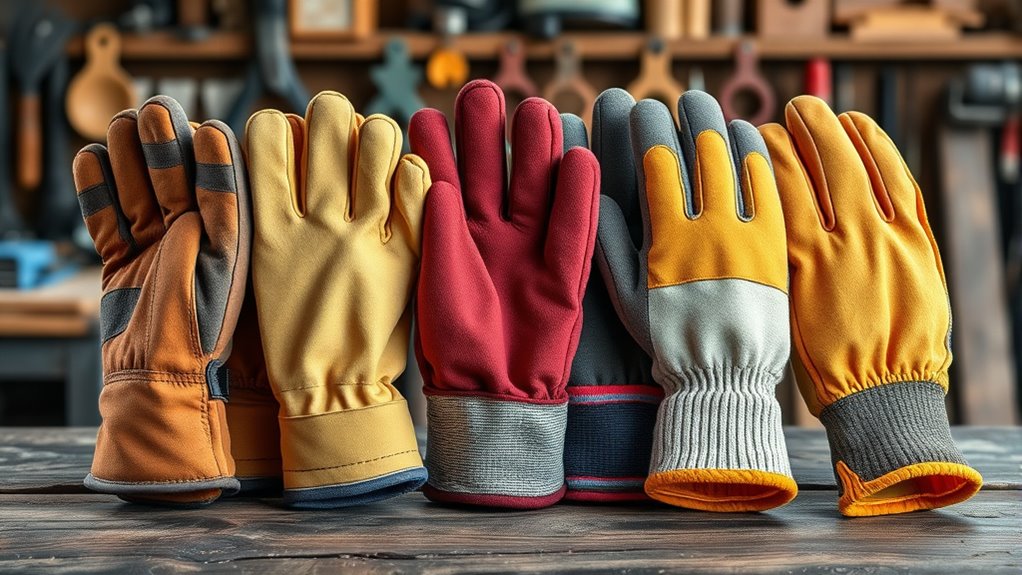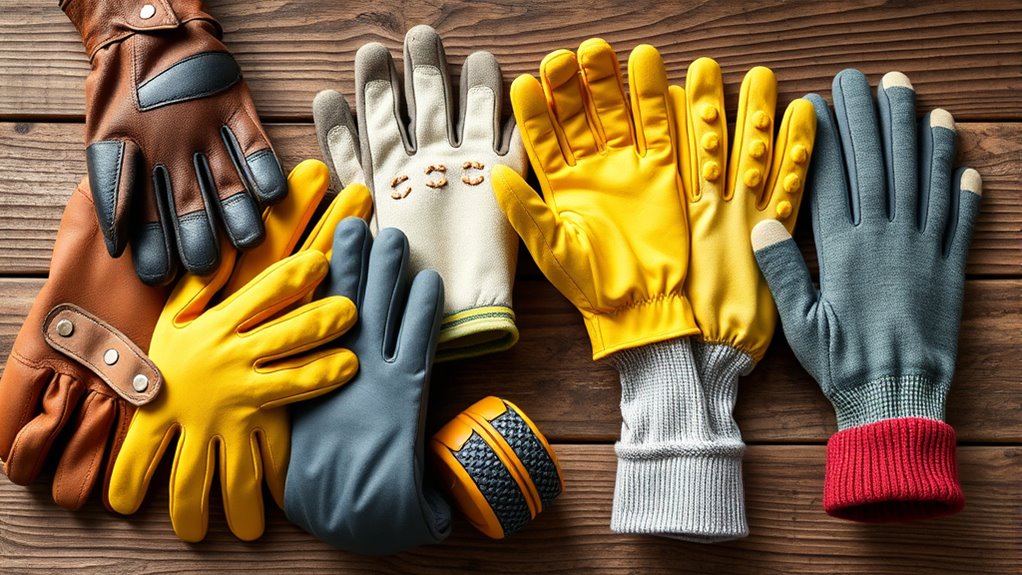When choosing work gloves for different tasks, consider the job’s hazards, dexterity needs, and environmental conditions. For heavy-duty tasks, opt for durable materials like leather or reinforced fabrics that resist tears and abrasion. For delicate work, select gloves with textured or silicone grip surfaces to prevent slipping. If you face wet, oily, or outdoor conditions, choose water-resistant or waterproof gloves with suitable grip features. Keep exploring for tips that help you pick the best gloves for your specific tasks.
Key Takeaways
- Match glove materials (leather, synthetic, rubber) to task demands for durability and protection.
- Prioritize grip features like textured surfaces or coatings for handling small or slippery objects.
- Consider water-resistant or waterproof gloves for wet or outdoor environments.
- Use oil-resistant gloves with textured surfaces for oily or greasy substances.
- Select gloves that balance durability and dexterity based on task-specific needs.

Choosing the right work gloves can considerably improve safety and efficiency on the job. When selecting gloves, one of the most important factors to take into account is material durability. You need gloves that can withstand the specific conditions of your task, whether it’s handling rough materials, exposure to chemicals, or repeated use. Durable materials like leather, reinforced synthetic fabrics, or rubber can resist tears, punctures, and abrasions, ensuring your gloves last longer and provide consistent protection. This durability not only saves you money over time but also minimizes the risk of glove failure during critical moments, keeping your hands protected from injury. Additionally, selecting gloves that match the task can prevent discomfort and improve overall performance.
Choosing durable gloves is key to safety and long-lasting protection on the job.
Grip enhancement is another vital aspect to think about. No matter how tough or durable your gloves are, if they don’t provide a reliable grip, your safety and productivity could suffer. Enhanced grip features, such as textured fingertips, rubber coatings, or silicone patterns, help you hold tools firmly, even in wet or slippery conditions. This reduces the likelihood of accidents caused by slipping or dropped objects, especially when working with small parts or delicate equipment. When grip is improved, you can work more confidently and efficiently, cutting down on fatigue and the need for constant adjustments or re-gripping.
Different tasks demand different combinations of material durability and grip enhancement. For instance, if you’re handling rough, abrasive materials like metal shards or construction debris, you’ll want gloves made from thick, tough materials like leather or reinforced synthetic fabrics. These materials offer the necessary durability to resist wear and tear while protecting your hands from cuts and abrasions. On the other hand, if your work involves delicate tasks, like assembling electronics or working with fine components, gloves with a textured surface or silicone grip will give you the dexterity and control you need, without sacrificing durability.
It’s essential to match the glove’s material and grip features to the specific demands of your job. For example, if you’re working outdoors in wet conditions, look for gloves with waterproof or water-resistant materials combined with grip-enhancing coatings. If your job involves handling greasy or oily substances, select gloves with oil-resistant properties and a textured surface to prevent slipping. Remember, the right combination of material durability and grip enhancement ensures you maintain both safety and productivity throughout your shift. For tasks involving specialized dog grooming tools, choosing gloves with the appropriate grip and durability can help prevent accidents and improve efficiency.
Frequently Asked Questions
How Do I Measure My Hand for the Perfect Glove Fit?
To measure your hand for the perfect glove fit, use measuring techniques like wrapping a tape measure around your palm’s widest part, just below your knuckles, excluding the thumb. Check glove sizing charts for accurate sizing, as sizes can vary between brands. Make sure you measure both hands and choose the size that best fits your dominant hand. This way, you’ll find gloves that provide comfort and ideal protection.
Are There Eco-Friendly Work Glove Options Available?
Yes, eco-friendly work gloves are available. You can find options made from sustainable materials like recycled fibers, organic cotton, and natural latex. Some brands also offer biodegradable gloves that break down safely in the environment. By choosing these eco-conscious options, you reduce your carbon footprint and support sustainability efforts, making your work safer for both you and the planet. Always check product labels for eco-friendly certifications or material details.
How Often Should I Replace My Work Gloves?
You should replace your work gloves based on their glove material and usage. Generally, if you notice tears, holes, or significant wear, it’s time for substitution. For heavy-duty tasks, check frequently and replace gloves every few weeks or sooner if damage occurs. Lightweight gloves may last longer but still need replacing once their material weakens. Regularly inspecting your gloves ensures safety and maximum protection during work.
Can Work Gloves Be Sanitized for Reuse?
Yes, work gloves can be sanitized for reuse if you perform proper glove sterilization. To guarantee reuse safety, clean gloves thoroughly with soap and water or use appropriate disinfectants, especially after handling hazardous materials. For added safety, consider using gloves that are designed for sterilization, like those made of latex or nitrile, which can withstand cleaning processes. Always follow manufacturer guidelines to prevent contamination and maintain glove integrity.
What Are the Best Gloves for Chemical Resistance?
Choosing gloves for chemical resistance is like picking armor for a battle—you want strong protection. You should focus on chemical compatibility and glove material. Nitrile offers excellent chemical resistance against many acids and oils, making it a top choice. But for organic solvents, neoprene works well. Always double-check the chemical resistance chart to make sure your gloves match the specific chemicals you handle, keeping your hands safe and secure.
Conclusion
Just as a skilled captain chooses the right sails for each voyage, selecting the proper work gloves guarantees your safety and efficiency. Each task is a different sea, demanding the right gear to navigate smoothly. When you match your gloves to your work, you’re steering your efforts with confidence, avoiding the storms of injury. Remember, your hands are the wind in your sails—equip them wisely, and every project will reach its safe harbor.









